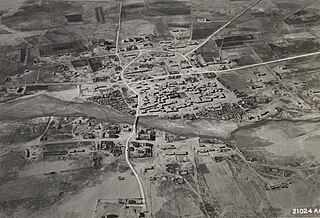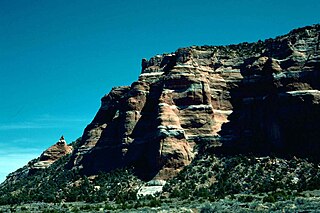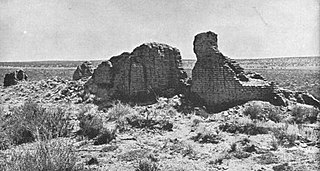
Santa Fe de Nuevo México was a province of the Spanish Empire and New Spain, and later a territory of independent Mexico. The first capital was San Juan de los Caballeros from 1598 until 1610, and from 1610 onward the capital was La Villa Real de la Santa Fe de San Francisco de Asís.

Francisco Vázquez de Coronado was a Spanish conquistador and explorer who led a large expedition from what is now Mexico to present-day Kansas through parts of the southwestern United States between 1540 and 1542. Vázquez de Coronado had hoped to reach the Cities of Cíbola, often referred to now as the mythical Seven Cities of Gold. His expedition marked the first European sightings of the Grand Canyon and the Colorado River, among other landmarks. His name is often Anglicized as Vasquez de Coronado or just Coronado.

Zuni Pueblo is a census-designated place (CDP) in McKinley County, New Mexico, United States. The population was 6,176 as of the 2020 Census. It is inhabited largely by members of the Zuni people.

The Zuni are Native American Pueblo peoples native to the Zuni River valley. The Zuni people today are federally recognized as the Zuni Tribe of the Zuni Reservation, New Mexico, and most live in the Pueblo of Zuni on the Zuni River, a tributary of the Little Colorado River, in western New Mexico, United States. The Pueblo of Zuni is 55 km (34 mi) south of Gallup, New Mexico. The Zuni tribe lived in multi level adobe houses. In addition to the reservation, the tribe owns trust lands in Catron County, New Mexico, and Apache County, Arizona. The Zuni call their homeland Halona Idiwan’a or Middle Place. The word Zuni is believed to derive from the Western Keres language (Acoma) word sɨ̂‧ni, or a cognate thereof.
Cibola most commonly refers to:

Melchor Díaz was a Spanish conquistador who was Governor of Culiacan. He is best known for leading a 25-man auxiliary party during the 1540 Coronado expedition. In December 1540 Díaz crossed the Colorado River which he named the Rio de Tizon, making him the first European in the modern state of California to set foot and explore west of the Colorado River, reaching mudpots near Cerro Prieto, and in the Imperial Valley.

Acoma Pueblo is a Native American pueblo approximately 60 miles (97 km) west of Albuquerque, New Mexico, in the United States.
Estevanico, also known as Mustafa Azemmouri and Esteban de Dorantes and Estevanico the Moor, was the first person of African descent to explore North America. He was one of the last four survivors of the Narváez expedition, along with Álvar Núñez Cabeza de Vaca, Andrés Dorantes de Carranza, and Alonso del Castillo Maldonado.

Chakwaina is a kachina which appears in Hopi, Zuni, and Keresan ceremonies, but does not appear in Tewa ceremonies. Although imagery of the kachina is varied, it is usually depicted as an ogre, with ferocious teeth and a black goatee and black mask with yellow eyes. Its spread throughout Pueblo culture is often associated with the Asa clan.
Marcos de Niza, OFM was a Franciscan friar and missionary from the city of Nice in the Duchy of Savoy. Marcos led the first Spanish expedition to explore what is now the American Southwest. His report of finding a "beautiful city", "more extensive than that of Mexico [City]", induced Viceroy Antonio de Mendoza to organize a large-scale entrada under the leadership of Francisco Vázquez de Coronado. Marcos served as a guide for this expedition but when they failed to find the wealth they expected, Coronado blamed Marcos, called him a liar and sent the friar back to Mexico in disgrace.

The Spanish Missions in New Mexico were a series of religious outposts in the Province of Santa Fe de Nuevo México — present day New Mexico. They were established by Franciscan friars under charter from the monarchs of the Spanish Empire and the government of the Viceroyalty of New Spain in a policy called Reductions to facilitate the conversion of Native Americans into Christianity.

The Tiguex War was the first named war between Europeans and Native Americans in what is now part of the United States. The war took place in New Spain, during the colonization of Nuevo México. It was fought in the winter of 1540–41 by the expedition of Francisco Vázquez de Coronado against the twelve or thirteen Pueblos or settlements of what would become the Tiguex Province of Nuevo México. These villages were along both sides of the Rio Grande, north and south of present-day Bernalillo, New Mexico.
Quivira was a province of the ancestral Wichita people, located near the Great Bend of the Arkansas River in central Kansas, The exact site may be near present-day Lyons extending northeast to Salina.

The Zuni Indian Reservation, also known as Pueblo of Zuni, is the homeland of the Zuni tribe of Native Americans. In Zuni language, the Zuni Pueblo people are referred to as A:shiwi, and the Zuni homeland is referred to as Halona Idiwan’a meaning Middle Place.

Hawikuh, was one of the largest of the Zuni pueblos at the time of the Spanish entrada. It was founded around 1400 AD. It was the first pueblo to be visited and conquered by Spanish explorers. The Spanish chroniclers referred to it as Cevola, Tzibola, or Cibola.

The Awatovi Ruins, spelled Awat'ovi in recent literature, are an archaeological site on the Hopi Reservation in northeastern Arizona, United States. The site contains the ruins of a pueblo estimated to be 500 years old, as well as those of a 17th-century Spanish mission. It was visited in the 16th century by members of Francisco Vázquez de Coronado's exploratory expedition. In the 1930s, Hopi artist Fred Kabotie was commissioned by the Peabody Museum of Archaeology and Ethnology of Harvard University to reproduce the prehistoric murals found during the excavation of the Awatovi Ruins. The site was designated a National Historic Landmark in 1964.

Coronado Historic Site is the Tiwa pueblo of Kuaua and a historic site that is part of the State-governed Museum of New Mexico system. It is located along U.S. Federal Route 550, 1 mile west of Bernalillo and 16 miles north of Albuquerque.

The myth of the Seven Cities of Gold, also known as the Seven Cities of Cíbola, was popular in the 16th century and later featured in several works of popular culture. According to legend, the seven cities of gold referred to Aztec mythology revolving around the Pueblos of the Spanish Nuevo México, modern New Mexico and Southwestern United States.
The Lower Zuni River Archeological District is an area of approximately 29,500 acres, comprising 89 distinct archeological sites. It is located approximately 24 miles northeast of St. Johns, Arizona, at the Arizona–New Mexico border, along the Zuni River.
Pedro de Tovar was a Spanish explorer, military man and colonial administrator. He was part of Francisco Vazquez de Coronado's expedition and led the first expedition to Cibola in 1540. Tovar was also the first European to hear about the existence of the Grand Canyon, although he did not get to see it. He was also a member of Nuño Beltrán de Guzmán's troops during the conquest of Nueva Galicia, as well as collaborating in the colonization of Guadalajara and the foundation of Culiacán, in modern Mexico. After that, he was alcalde of Nueva Galicia and Culiacán.














